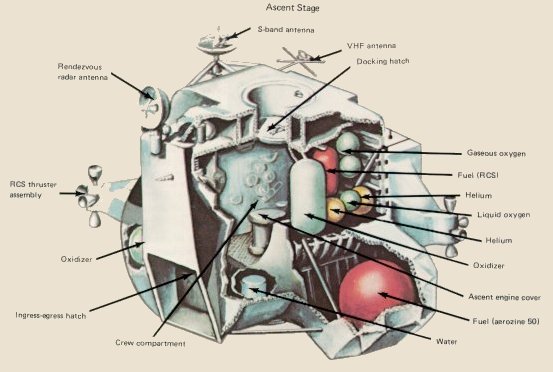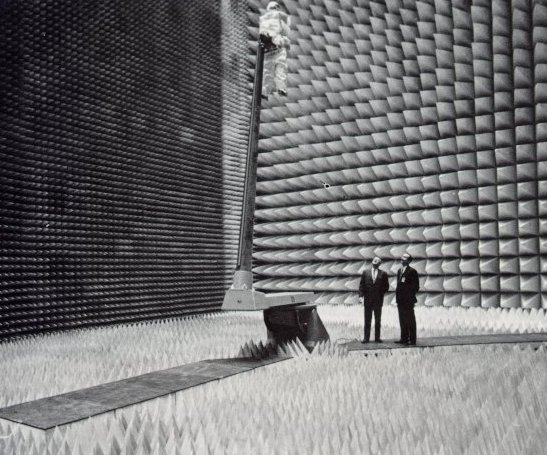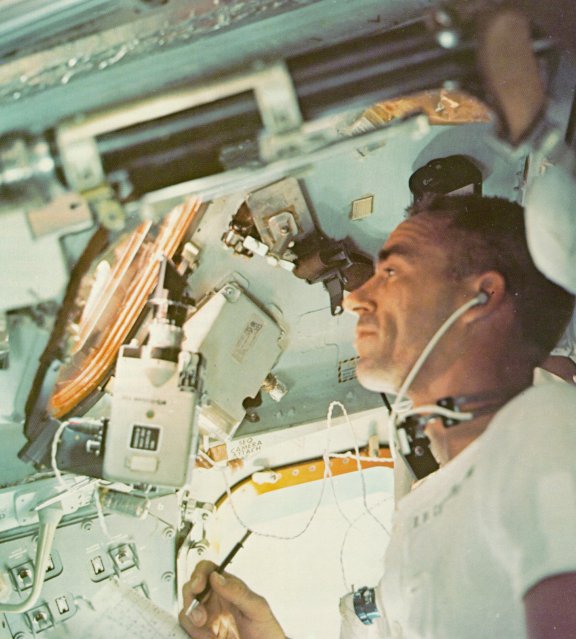Apollo Expeditions to the Moon
COMPLEX SUBSYSTEMS PERFORMED VITAL FUNCTIONS
At the heart of each spacecraft were its subsystems. "Subsystem" is space-age
jargon for a mechanical or electronic device that performs a specific function such as
providing oxygen, electric power, and even bathroom facilities. CSM and LM subsystems
performed similar functions, but differed in their design because each had to
be adapted to the peculiarities of the spacecraft and its environment.
Begin with the environmental control system - the life-support system for man
and his machine. It was a marvel of efficiency and reliability, with weight and volume
at a premium. A scuba diver uses a tank of air in 60 minutes; in Apollo an equivalent
amount of oxygen lasted 15 hours. Oxygen was not simply inhaled once and then
discarded: the exhaled gas was scrubbed to eliminate its CO2 recycled, and reused.
At the same time, its temperature was maintained at a comfortable level, moisture was
removed, and odors were eliminated. That's not all: the same life-support system also
maintained the cabin at the right pressure, provided hot and cold water, and a circulating
coolant to keep all the electronic gear at the proper temperature. (In the weightless
environment of space, there are no convective currents, and equipment must be cooled
by means of circulating fluids.) Because astronauts' lives depended on this systern,
most of the functions were provided with redundancy - and yet the entire unit was not
much bigger than a window air conditioner.
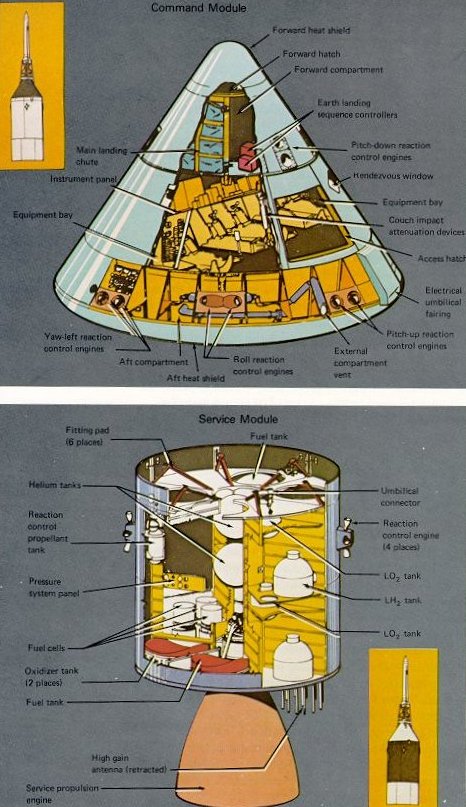
|
Above: Looking like a huge toy top
the conical command module
was crammed with some of
the most complex equipment
ever sent into space. The three
astronaut couches were surrounded by instrument panels,
navigation gear, radios, life-support systems, and small
engines to keep it stable during
reentry. The entire cone, 11
feet long and 13 feet in diameter, was protected by a
charring heat shield. The 6.5-ton CM was all that was
finally left of the 3000-ton
Saturn V stack that lifted oft
on the journey to the Moon.
Below: Packed with plumbing and
tanks, the service module was
the CM's constant companion
until just before reentry. So
all components not needed
during the last few minutes of
flight, and therefore requiring
no protection against reentry
heat, were transported in this
module. It carried oxygen for
most of the trip; fuel cells to
generate electricity (along
with the oxygen and hydrogen to run them);
small engines to control pitch, roll,
and yaw; and a large engine
to propel the spacecraft into -and out of- lunar orbit.
|
| | |
The lunar module was also a two-part
spacecraft. Its lower or descent stage had the landing
gear and engines and fuel
needed for the landing. When
the LM blasted off the Moon,
the descent stage served as
the launching pad for its
companion ascent stage,
which was also home for the
two explorers on the surface.
In function if not in looks the
LM was like the CM, full of
gear to communicate, navigate, and rendezvous. But it
also had its own propulsion
system, an engine to lift it off
the Moon and send it on a
course toward the command
module orbiting above.
|
How do you generate enough electric power to run a ship in space? In the CSM,
the answer was fuel cells; in the LM, storage batteries. Apollo fuel cells used oxygen
and hydrogen -stored as liquids at extremely cold temperatures- that when combined
chemically yielded electric power and, as a byproduct, water for drinking. (In early
flights the water contained entrapped bubbles of hydrogen, which caused the astronauts
no real harm but engendered major gastronomical discomfort. This led to loud complaints,
and the problem was finally solved by installing special diaphragms in the
system.) The fuel-cell power system was efficient, clean, and absolutely pollution-free.
Storing oxygen and hydrogen required new advances in leakproof insulated containers.
lf an Apollo hydrogen tank were filled with ice and placed in a room at 70° F, it
would take 8.5 years for the ice to melt. lf an automobile tire leaked at the same rate
as these tanks, it would take 30 million years to go flat.
"Houston, this is Tranquility." These words soon would be heard from another
world, coming from an astronaut walking on the Moon, relayed to the LM, then to a
tracking station in Australia or Spain or California, and on to Mission Control in
Houston with only two seconds' delay. Communications from the Moon were clearer
and certainly more reliable than they were from my home in Nassau Bay (a stone's
throw from the Manned Spacecraft Center) to downtown Houston. At the same time,
a tiny instrument would register a reading in the astronauts' life-support system, and
a few seconds later an engineer in Mission Control would see a variation in oxygen
pressure, or a doctor a change in heart rate; and around the world people would watch
on their home television sets. Bebind all of this would be the Apollo communications
system-designed to be the astronauts' life line back to Earth, to be compact and
lightweight, and yet to function with absolute reliability; an array of receivers,
transmitters, power supplies and antennas, all tuned to perfection, that allowed the men and
equipment on the ground to extend the capabilities of the astronauts and their ships.
(Later on, when the computer on Apollo 11's LM was overloaded during the critical
final seconds of the landing, it was this communications system that enabled a highly
skilled flight controller named Steve Bales to tell Neil Armstrong that it was safe to
disregard the overload alarms and to go ahead with the lunar landing.)

|
Like a plumber's dream, the LM's environmental control system nestled in
a corner of the ascent stage. Those
hoses provided pure oxygen to two astronauts at a pressure one-third that
of normal atmosphere, and at a comfortable temperature. The unit
recirculated the gas, scrubbed out CO2 and
moisture exhaled, and replenished oxygen as it was used up.
|
| | |
Sound is deadened and not an echo
can be heard in this anechoic test
chamber. Used to simulate reflection-free space, its floor, walls, and ceiling
are completely covered with foam
pyramids that absorb stray radiation,
so that an antenna's patterns can be
accurately measured. Here two NASA
engineers inspect a test setup of an
astronaut's backpack. Any interference between the astronaut and his
small antenna could be detected and
fixed before a real astronaut set foot
on the Moon.
|
If you had to single out one subsystem as being most important, most complex,
and yet most demanding in performance and precision, it would be Guidance and
Navigation. Its function: to guide Apollo across 250,000 miles of empty space; achieve
a precise orbit around the Moon; land on its surface within a few yards of a predesignated
spot; guide LM from the surface to a rendezvous in lunar orbit; guide the CM
to hit the Earth's atmosphere within a 27-mile "corridor" where the air was thick
enough to capture the spacecraft, and yet thin enough so as not to burn it up; and
finally land it close to a recovery ship in the middle of the Pacific Occan. Designed by
the Massachusetts Institute of Technology under Stark Draper's leadership, G&N consisted
of a miniature computer with an incredible amount of information in its memory;
an array of gyroscopes and accelerometers called the inertial-measurement unit; and
a space sextant to enable the navigator to take star sightings. Together they determined
precisely the spacecraft location between Earth and Moon, and how best to burn the
engines to correct the ship's course or to land at tbe right spot on the Moon with a
minimum expenditure of fuel. Precision was of utmost importance; there was no
margin for error, and there were no reserves for a missed approach to the Moon. In
Apollo 11, Eagle landed at Tranquility Base, after burning its descent engine for 12
minutes, with only 20 seconds of landing fuel remaining.
| | |
Like new Magellans, astronauts learned to navigate in space.
Here Walt Cunningham makes his
observations through a spacecraft window.
The tools of a space navigator included a sextant
to sight on the stars, a gyroscopically stabilized
platform to hold a constant reference in
space, and a computer to link the data and make
the most complex and precise calculations.
|
But the guidance system only told us where the spacecraft was and how to correct
its course. It provided the brain, while the propulsion system provided the brawn in
the form of rocket engines, propellant tanks, valves, and plumbing. There were 50
engines on the spacecraft, smaller but much more numerous than those on the combined
three stages of the Saturn that provided the launch toward the Moon. Most of
them - 16 on the LM, 16 on the SM, and 12 on the CM - furnished only 100 pounds
of thrust apiece; they oriented the craft in any desired direction just as an aircraft's
elevators, ailerons, and rudder control pitch, roll, and yaw.
Three of the engines were much larger. On the service module a 20,500-pound-thrust
engine injected Apollo into lunar orbit, and later brought it back home; on the
LM there was a 10,500-pound-thrust engine for descent, and a 3500 pounder for
ascent. All three had to work: a failure would have stranded astronauts on the Moon
or in lunar orbit. They were designed with reliabillty as the number one consideration.
They used hypergolic propellants that burned spontaneously on contact and required
no spark plugs; the propellants were pressure-fed into the thrust chamber by bottled
helium, eliminating complex pumps; and the rocket nozzles were coated with an ablative
material for heat protection, avoiding the need for intricate cooling systems.
Three other engines could provide instant thrust at launch to get the spacecraft
away from the Saturn if it should inadvertently tumble or explode. The largest of these
produced 160,000 pounds of thrust, considerably more than the Redstone booster
which propelled Alan Shepard on America's first manned spaceflight. (Since we never
had an abort at launch, these three were never used.)
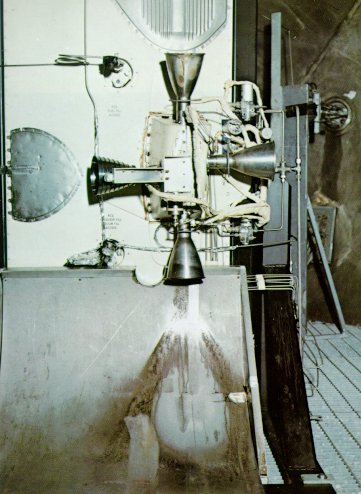
|
Because there is no air to deflect, a spacecraft
lacks rudders or ailerons. Instead, it has small
rocket engines to pitch it up or down, to yaw it
left or right, or to roll it about one axis. Sixteen
of them were mounted on the service module, in
"quads" of four. Here one quad is tested to make
sure that hot rocket exhaust will not burn a hole
in the spacecraft's thin skin.
|
| | |
Similar in shape but not size were the three big
engines aboard Apollo spacecraft. Two of them
had no backup, so they were designed to be the
most reliable engines ever built. lf the service-propulsion engine
failed in lunar orbit, three
astronauts would be unable to return home; if the
ascent engine failed on the Moon, it would leave
two explorers stranded. (A descent-engine failure
would not be as critical, because the ascent engine
might be used to save the crew members.)
|
There were other subsystems, each with its own intricacies of design, and, more
often than not, with its share of problems. There were displays and controls, backup
guidance systems, a lunar landing gear on the LM and an Earth landing system
(parachutes) on the CM, and a docking system designed with the precision of a Swiss watch,
yet strong enough to stop a freight car. There were also those things that fell between
the subsystems: wires, tubes, plumbing, valves, switches, relays, circuit breakers, and
explosive charges that started, stopped, ejected. separated, or otherwise activated
various sequences.
|


